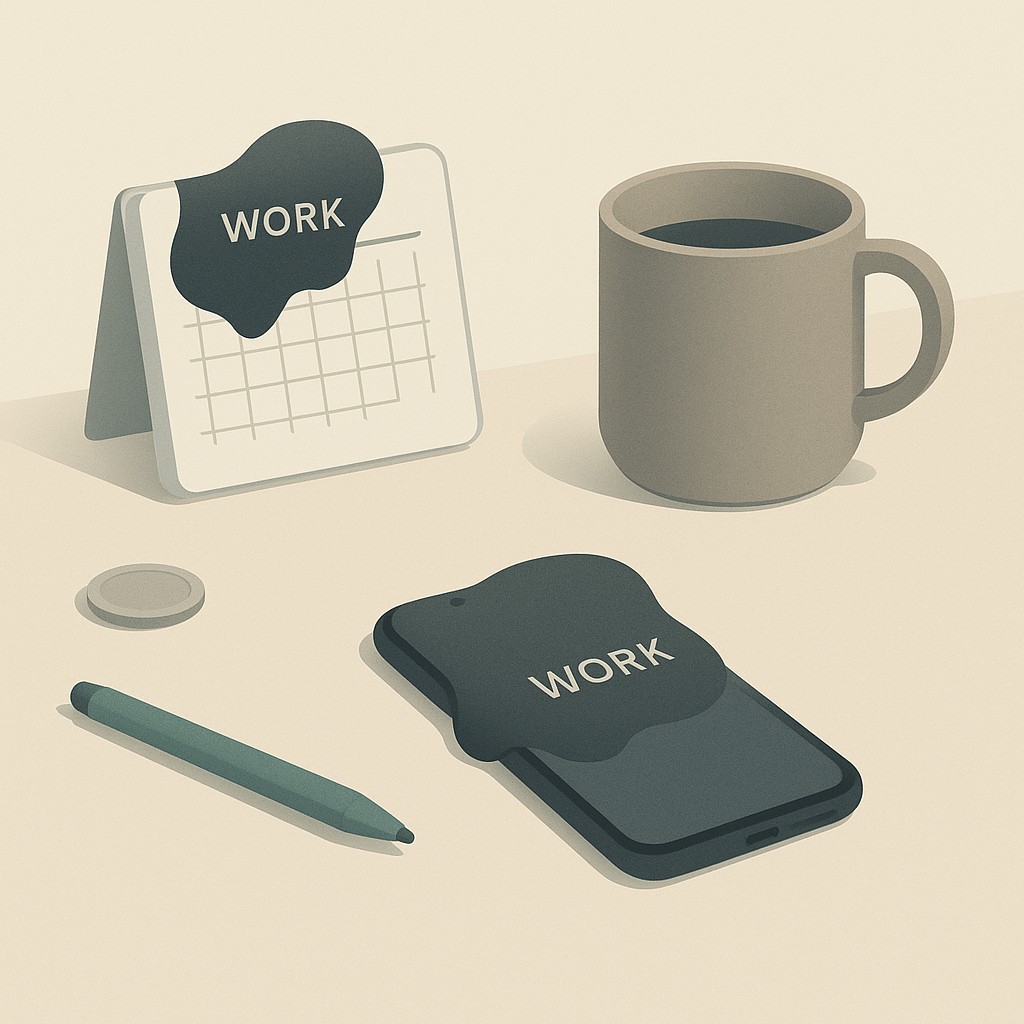Set and Enforce Work Boundaries That Actually Hold
Set and Enforce Work Boundaries That Actually Hold

When Work Seeps Into Everything
I spent part of my parental leave—supposedly a time to disconnect and be present—working. I was grateful for the flexibility, but the overlap felt wrong and honestly, it left me more exhausted than I expected.
It happened because we had a small team. There simply wasn’t anyone else to pick up the slack, so even as I held my newborn, my phone was never fully out of reach. Every ping felt urgent, every request felt non-negotiable. If you’ve been in a team like this, you know the trap. When there’s no one to hand work off to, you can’t set and enforce work boundaries, and availability stops being a choice.
I’ll be clear. I was grateful to have leave at all. Plenty of people never get that. But gratitude didn’t erase the strain. If anything, it made me quieter about how much it was costing me.
Six months ago, I would have told you it was just because I was fully remote. Maybe the problem was the location, not the boundaries. I know better now.
The Variable You Control Is the Limit
Here’s the turning point. I kept thinking the problem was where I worked, but the real variable I could control was the limit, not the location. Balance isn’t about location. It’s about boundaries. Once I let go of the idea that remote work is inherently boundaryless, I could start focusing on what I actually could change.

For a while, I clung to this fantasy that an office would create a clean break for me. Maybe if I were in an office, I could’ve had a clean break. But the reality is that when work follows us home via technology, lines blur fast—nineteen studies have linked after-hours smartphone use to more work-life conflict with measurable effect sizes.
Here’s the core principle I needed to learn, and you probably do too. Unless you set and enforce work boundaries, unbounded availability just invites endless work. If you don’t set limits, work will take as much as you give it, and then some. It’s not your calendar that creates balance. It’s your rules.
The hard truth? No one else will set your limits for you, no matter how supportive your team. You have to name them and enforce them, for your own sake and for the team’s rhythm. Once I accepted that, things started to change—slowly but meaningfully.
How to Set and Enforce Work Boundaries That Hold Up Under Pressure
The basics of building real boundaries are surprisingly mechanical. Pick your working hours, protect deep work time, and decide how quickly you’ll respond to requests. Simple, but harder in practice—which is why you need more than a private promise to yourself. What makes boundaries stick isn’t willpower, but visible signals (like calendar blocks or status toggles), and shared systems that help your team rely on those signals. Without them, you’re just hoping coworkers read your mind, and that’s a recipe for fuzzy expectations and constant interruption. I’d much rather have clear guardrails than try to remember where I “should” draw the line every week.
The transition between work and life doesn’t just happen on its own—you have to enforce work-life boundaries. You have to assemble it. For me, it’s as literal as closing the laptop, changing into different clothes, or stepping outside for ten minutes. Whatever signals “work is done” to your brain—do that on repeat.
Here’s one that stuck, even though it started by accident. Every day, after closing out that last Slack message, I do the dinner dishes—even if they’re not mine. There’s something grounding about hot water and scraping plates; it breaks the digital trance. I remember one afternoon—I lost track of time, and when I finally shut the laptop, I walked into the kitchen to find yesterday’s coffee mug still floating in the sink. I just stood there, watching soap bubble up around my fingerprints, realizing for the first time that I’d built a ritual without meaning to.
Some evenings, I take a brisk walk around the block, no headphones, just noticing the change in light. On rare days when I meet a coworker in person, we’ll do one lap around the parking lot before heading home, talking about literally anything but Jira tickets. This sounds trivial, but my energy for “real life” actually came back when I started doing these tiny things with purpose. Oddly enough, a small act like wiping down the counter can draw a sharper boundary than a status change in a chat app. Try it if nothing else works for you.
Guardrails shouldn’t just protect your time; they should establish team norms for availability. They should shape how your team interacts after-hours. Batch your messages and use scheduled send, so nobody gets “reply now?” texts at bedtime. Keep Slack notifications snoozed by default during focus or recovery time, and don’t be shy about saying so. Your rules become real only if you signal and maintain them.
To make these limits resilient, look ahead. Document your work. Delegate what you can. Plan coverage so “urgent” doesn’t always mean “you.” That’s how boundaries persist—even when life pulls you away for something as important as family.
Boundaries in Action: Making Limits Real on Small Remote Teams
Start with a single week. Don’t overhaul your whole workflow. Pick one week, set explicit working hours, and let your team know that you’re running an experiment to find real limits that don’t derail delivery. Short, simple. If it doesn’t stick, you’ve risked nothing except getting better at noticing where the seams are thin.
Remember that mug I mentioned earlier? Some days, that felt like my only marker that the workday was actually done.
Here’s how it played out for me on a typical day. I’d block 9 to 3 as my core hours on the calendar, with two 90-minute focus blocks carved out (protected like gold, even if the “focus” was a diaper change or a much-needed break). When Slack buzzed with a drive-by ask in the middle of those blocks—“Do you have a second?”—I stopped the reflex to answer immediately. Instead, I’d write a quick note.
“I’m in deep work right now—can you file this as a ticket or send as async?” It felt awkward at first (especially when you want to be helpful), but scheduling replies or setting things to send later made it clear. Responsiveness was a rhythm, not a reaction. The more we stuck to it, the easier it got to maintain flow without piling up pressure.
To make this visible, I started using every signal I could. My status became gospel. “🕒 Focus,” “🏡 Away,” or “💤 Off until tomorrow.” Calendar blocks were not just for me, but for the team—so accidental pings slowed down fast. If I was heads-down, that was broadcast. At the start of every day, I’d update both, and check again after lunch. It’s amazing how much friction you can remove just by showing others where your attention can’t go.
What about urgent stuff? Here’s the trick. Document a pathway. Who covers your tickets? Where’s the quick-reference doc for that “just in case” production scare? I started trading five minutes of notes or a decision log for hours of regained focus—not because I loved documentation, but because skipping it meant more chaos later. Your future bandwidth will thank you, I promise.
Limits don’t isolate you; they do the opposite. For async-first teams, senior leadership needs to value documentation and invest in tools that make distributed teamwork actually work. If anything, clearer boundaries are a force multiplier for collaboration. They make all the moving parts stronger, not weaker.
One thing I still struggle with—I’ve never figured out how to stop checking notifications first thing in the morning. Maybe one day I’ll break that habit, but for now, I just try to keep the apps off until after that first cup of coffee.
Your Boundaries Drive Your Performance—Not Just Your Availability
If you’re like I was, you probably worry that work boundaries for engineers make you less responsive, or look like you’re not pulling your weight. I used to think the same thing. That limiting my hours meant I’d be less helpful. Turns out, defending those lines made me sharper, not smaller.
Here’s why. When you cut down on constant context-switching, you actually get more done. Your brain gets a chance to recover, and your output gets better. Trying to be “always available” is actually a drag on throughput. You just end up tired and scattered, working at half-strength. I’ve learned I do my best work at a steady pace—no more heroic sprints that trade today’s impact for tomorrow’s burnout.
If you’re a software engineer or AI builder who needs to draft posts, release notes, or docs, use our app to generate AI-powered content fast, with your goals, constraints, and tone, so you keep focus.
And it’s not just an individual thing. Culture needs to change along with policy. Just rolling out a right to disconnect policy won’t shift culture unless teams also put real norms and practices behind it. Leaving on time needs to be normal. Staying late isn’t a badge of honor anymore.
So. Set boundaries at work. Make them explicit and stand by them, daily. No one else will do it for you—so start now, and keep them visible. You’ll be surprised how much clearer, more sustainable, and frankly, more respected your work becomes.
Enjoyed this post? For more insights on engineering leadership, mindful productivity, and navigating the modern workday, follow me on LinkedIn to stay inspired and join the conversation.
You can also view and comment on the original post here .
